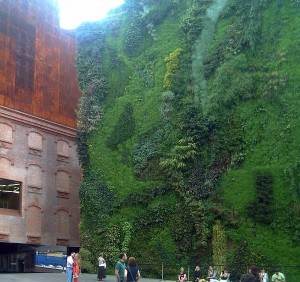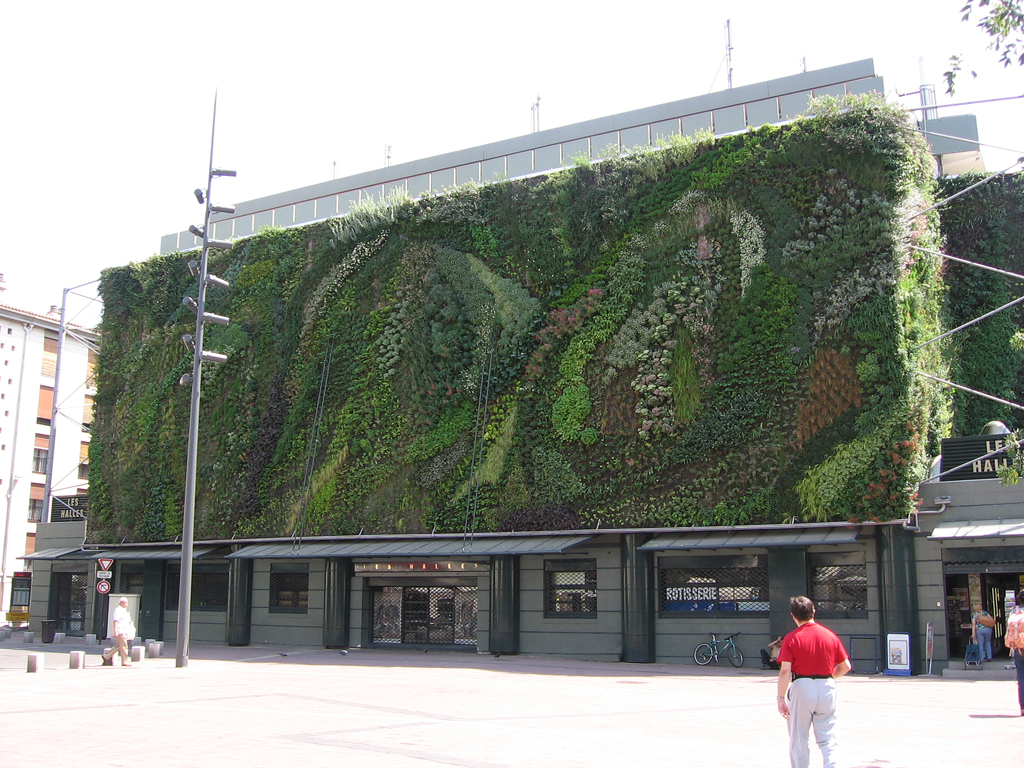Living Walls
Posted in Gardening Tips, The Orchid Show on February 28 2012, by Sonia Uyterhoeven
Sonia Uyterhoeven is the NYBG’s Gardener for Public Education.
 It turns out that the French botanist and designer, Patrick Blanc, is in fact very green. If you are unaware of his reputation as “The Green Man,” the eccentric eco-artist and designer sports bright green hair, and electric green nail polish painted on a long, curvy thumb nail.
It turns out that the French botanist and designer, Patrick Blanc, is in fact very green. If you are unaware of his reputation as “The Green Man,” the eccentric eco-artist and designer sports bright green hair, and electric green nail polish painted on a long, curvy thumb nail.
With a strong background in botany under his belt, Blanc has explored the natural world while traveling extensively throughout the tropics. Through his travels he has paid particular attention to how plants situate themselves in their native environments–tangling and twisting amongst other species, climbing over each other, and colonizing small territories in diverse communities.
Blanc has paired his fascination with plants and their natural communities with new technologies, and is now one of the leaders in the field of vertical gardening, or “living walls.” In this day and age when space is at a premium–particularly in urban environments–vertical gardening is quite literally a breath of fresh air.
There are a number of systems for building living walls on the market and Patrick Blanc has chosen a technique based on hydroponics. He uses a pocket system made of rot-proof felt that has good capillary action. The felt is backed with a layer of PVC designed to hold in moisture, protect the building, and provide support. The PVC in turn is mounted on a sturdy metal framework.
Just as in hydroponics, there is no soil involved. Water enriched with nutrients runs through the living wall. The excess is collected at the bottom by a trough and then recirculated to the top. Plants grown in this system are on a regulated watering and feeding schedule. Their roots do not have to strike out like pioneers in search of water and nutrients, allowing them to grow in a confined space without causing damage to the wall.
Grooming the plants–removing dead foliage and pruning some of them back into shape–is part of the maintenance process. The wall is allowed to grow wild for six months before gardeners, looking more like window cleaners than their title suggests, come in to maintain the wall.
I have, of course, made this sound much easier than it is. The felt fabric of the wall can be susceptible to algae build up, the water and nutrient system must be carefully monitored, and the weight of the structure must be taken into account, and only with proper attention paid to all of these measures will the plants thrive. Even after all of these factors are taken into account, there is still more to be done to determine whether the plants thrive or fail.
To aid in the process of establishing them, Blanc acts on the well-known principle of choosing ‘the right plant for the right place.’ He chooses plants that are naturally found growing on rock faces or in areas of high humidity. On the bottom layers of his design he specifically selects plants that prefer shade and moisture. On the top of the walls, where there is a greater variation in temperature and sunlight, he chooses sun- and drought-tolerant candidates.
If you are looking into building a living wall on your building, it is important to thoroughly research the topic and assess the options. Aside from popular pocket systems, there are also modular or panel systems. Panels are made out of a variety of materials, such as recycled plastics and stainless steel. The cells in the panel can be filled with soil-free mixes, roof media coir, or felt geo-textile.

Something to look out for is the size of the cells or growing compartments. Six-inch-deep cells are preferred by most growers, as the four-inch-deep variety tends to limit your plant choices. Water-proofing behind the wall, weight requirements, a reliable drip irrigation system, a good liquid fertilization schedule, ventilation and temperature fluctuations all need to be taken into consideration. I have seen green walls fail miserably when the buyer focused only on the construction and not the care.
For those of you interested in researching this fascinating technique, start your journey into the world of living walls by exploring some of the companies listed below. Better yet, come to our Orchid Show to see ‘Patrick Blanc’s Vertical Gardens’ on display from March 3 through April 22, 2012. Be sure to reserve your tickets as early as possible.
External resources on vertical gardening:
Tournesol
GSky
GLT – Green Living Technologies
Woolly Pocket
ELT Easy Green
“Green wall” photos courtesy of Wikimedia Commons. Portrait courtesy of Patrick Blanc.



Thanks for this. It answers a lot of questions I had about maintenance on living walls.